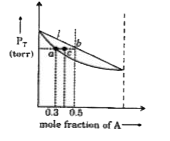An element of density 7.2 g cm−3 occurs in bcc structure with unit cell edge of 280 pm. Calculate molecular mass of the element and number of atoms present in 100 g of the element.Solution in Malayalam
The molecular mass of the element using following equation, and from molecular mass determine the number of atoms present in 100 g of the element.
Let M be the molar mass of the element.
Volume of unit cell = a3=(280×10−10cm)3=21.95×10−24cm3
In a body centred cubic structure, z = 2
Density = z×MNA×a3⇒M=ρ×NA×a32
M = 7.2gcm−3×6.023×1023mol−1×21.95×10−24cm−32=47.59gmol−1
47.59 g of the element contain 6.023×1023 atoms.
Therefore, number of atoms in 100 g of the element = 6.023×1023atoms mol−1×100g47.59g mol−1
= 12.656×1023 atoms
Topper's Solved these Questions
- BOOK - BRILLIANT PUBLICATIONCHAPTER - SOLID STATEEXERCISE - LEVEL-I50videos
SOLID STATE
- BOOK - BRILLIANT PUBLICATIONCHAPTER - SOLID STATEEXERCISE - LEVEL-II50videos
SOLID STATE
- BOOK - BRILLIANT PUBLICATIONCHAPTER - SOLID STATEEXERCISE - QUESTION (LEVEL -II) (Assertion-Reason)4videos
SOLID STATE
- BOOK - BRILLIANT PUBLICATIONCHAPTER - REDOX REACTION & ELECTROCHEMISTRYEXERCISE - QUESTION (ELECTROCHEMISTRY) (LEVEL -II) (ASSERTION-REASON)3videos
REDOX REACTION & ELECTROCHEMISTRY
- BOOK - BRILLIANT PUBLICATIONCHAPTER - SOLUTIONSEXERCISE - Level-III (Linked Comprehension Type)12videos
SOLUTIONS
Similar Questions
The radius of a di val ent cation M2+ is 94 pm and of divalent anion X2− is 146 pm. Thus, M2X2− has
03:55View SolutionTotal number of voids in 0.5 mole of a compound forming hexagonal closed packed structure are
03:31View SolutionAssertion (A) : In Rock salt type structuires, all the coctahedral voids in the close packing of anions are occupied by cations.
Reason(R): In Rock salt structure, the distance of closest apprach between two anions is equal to hal the face diagonal of unit cell.05:11View SolutionAssertion: After the electrolysis of aqueous CuSO4 solution pH decreases.
Reason: Sulphuric acid is formed.05:01View Solution1 mole of A and 1 mole B are mixed together to form an ideal solution at 25∘C. Solution is placed in a vessel fitted with piston. If pressure on the solution is reduced isothermally.

Correct relationship between P∘AandP∘B is02:24View SolutionAn element occurs in bcc structure with edge length of 288 pm. Its density is 7.2g/cm3
Calculate atomic mass of element.03:38View SolutionAs element cystallises in BCC structure. The edge length of its unit cell is 288 pm. It the density of the crystals is 7.2gcm−3 , what is the atomic mass of the element ?
(b) How many atoms of the element are presnet in 100g ?04:34View SolutionAn element has a body-centred cubic (bcc) structure with cell edge of 288 pm. The density of the element is 7.2 g//cm^3 . How many atoms are present in 208 g of the element ?
01:55View SolutionAn element (density =6.8gcm−3 ) occurs in bcc structure with cell edge of 290pm .Calculate the number of atoms present in 200g of the element:-
07:23View Solutionएक तत्व (परमाणु भार 100 ग्राम/मोल) जिसकी संरचना bcc है तथा इकाई सेल कोर 400 pm है, तत्व का घनत्व होगा-
04:32View SolutionAn element has a body-centred cubic (bcc) structure with a cell edge of 288 pm . The density of the element is 7.2 g/cm3 . How many atoms are present in 208 g of the element ?
05:53View SolutionAn element has bcc structures with a cell edge of 288 pm. The density of the element is 7.2gcm−3. How many atoms are present in 208 g of the element.
View SolutionAn element occurs in BCC structure with cell edge of 288 pm. It is 7.2g cm^(-3) . Calculate the atomic mass of the element.
View SolutionAn element has a bcc structure with a cell edge of 288 pm. The density of the element is 7.2gcm−3. How many atoms are present in 208g of the element?
01:37View SolutionAn element has a bcc structure with a cell edge of 288 pm. The density of the element is 7.2gcm−3. How many atoms are present in 208g of the element?
02:31View SolutionAn element (atomic mass 100 g/mol ) having bcc structure has cell edge 400 pm . Then density of the element is ________.
View Solution

